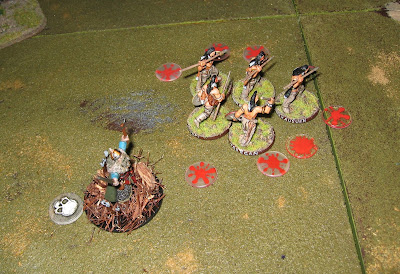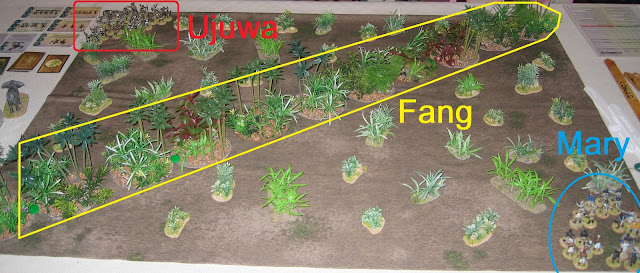Introduction
I don't think I've mentioned this before on my blog, but a group of us are running an escalation league for SAGA at the Helensburgh Alternative Hobby Association (HAHA).
What is this? Well, it's modelled on the "Tale of four gamers" concept which pops up in White Dwarf magazine every year or two. At the simplest, a number of people commit to collecting forces for some game system over a fixed time period, playing such games as can be managed at regular intervals.
The full rules for our league can be found here: escalation-league.docx , if anyone is interested.
Starter for Ten
 |
| 2 games in progress, with various dice, boards and other paraphernalia scattered around the edges |
Since this was the first meeting for our league, each participant brought along a warlord and 1 point of troops for their chosen warband. Most people chose 4 hearthguard, but a few had 8 warriors as their 1 point's worth of troops. Interestingly, everyone had selected a different faction, so we didn't have the monotony of 8 Viking warbands 😃.
There were 8 players present for this meeting, which was far more than I had imagined would be interested when the idea of a league was first proposed back in November 2019. We even had a visitor who had travelled from Fort William (some 2 hours away) especially for the evening. I hope we were sufficiently good hosts to make this level of dedication worthwhile!
The players were a mixture of veterans like myself and relative newcomers who wish to start playing SAGA. Most/all of us are collecting a fresh army for the Escalation League, even if a few of us already have quite a lot of figures for other warbands. After all, one of the main purposes is mutual encouragement!
The "Duel" Scenario
The format of the evening was a series of individual duels. We created two simple 2x2 foot boards; the rules for the scenario were thus:
- Each warband will deploy in the centre of one tile, diametrically opposite to their opponent (i.e. slightly more than a standard 'M' foot move from the table centre).
- The game will last for 3 turns.
- At the end of the game, any player whose warlord is standing on the board's centre spot will score 2 victory points.
- Any player who eliminates his opponent's warlord will score 1 victory point (unless he/she is already scoring 2 points for 'centre of table').
...and that's it! Really simple.
We managed to rattle through quite a few of these short matches over the course of 2 hours or so. Some of the games were a bit slower where new players weren't as familiar with the rules as the old hands, but everyone played at least one match and most played two or three.
Highlights
 |
| Skraelings are massacred by a very skillful (and probably very lost!) Jomsviking warlord. |
 |
| Saracens take the fight to Normans in what looks to be quite an uneven match |
 |
| Crusaders trying to toss the Jomsviking chieftain over a cliff and into the sea. I cannot remember if they succeeded or not. |
 |
| With all their hearthguards already dead or dying, Anglo Saxon and Anglo Dane warlords kill each other in a final, deadly embrace. |
 |
| Skraeling (with Moose totem) and Anglo Saxon warlords fight to mutual exhaustion - but the Saxon holds the centre ground |
Conclusion
As the primary organiser of this league, I was really not sure how the first evening would work. I need not have worried: everyone had a great time and the "duel" format worked really well.
It became quite obvious over the course of the evening that some faction's battle boards are better suited to very small forces than others. At the extreme ends, the Anglo Saxons couldn't use any of their abilities which work for very large units, whilst the Anglo Danes' "Intimidation" effect was particularly potent.
Even though there may have been some minor balance issues, everyone was good-natured and took their wins and losses gracefully. It probably helped that about half the group (including myself) failed to score a single victory point all night - at least there wasn't one poor soul left alone at the bottom of the scoring!
Part 2 of the escalation league is here -->
Part 2 of the escalation league is here -->


































